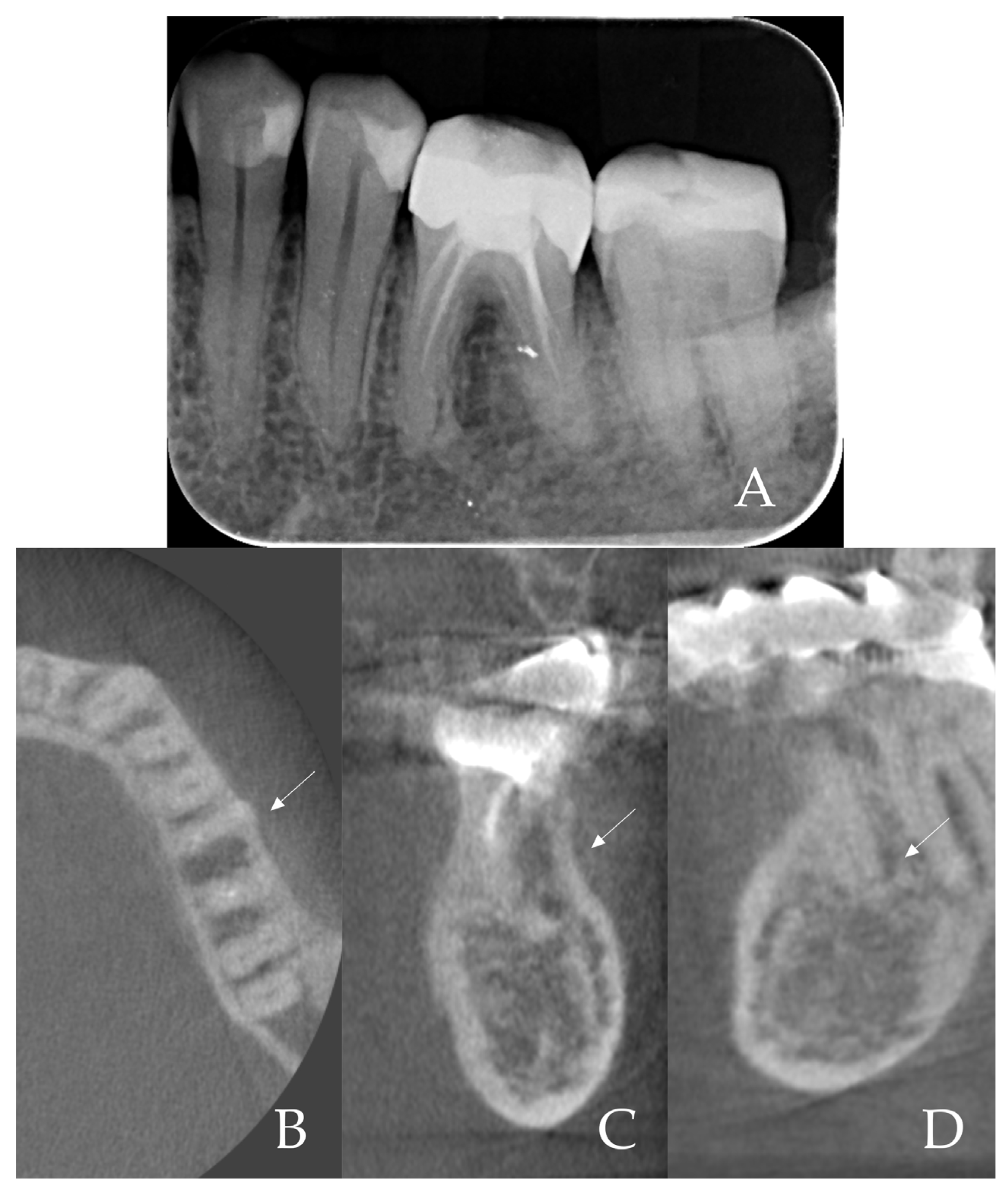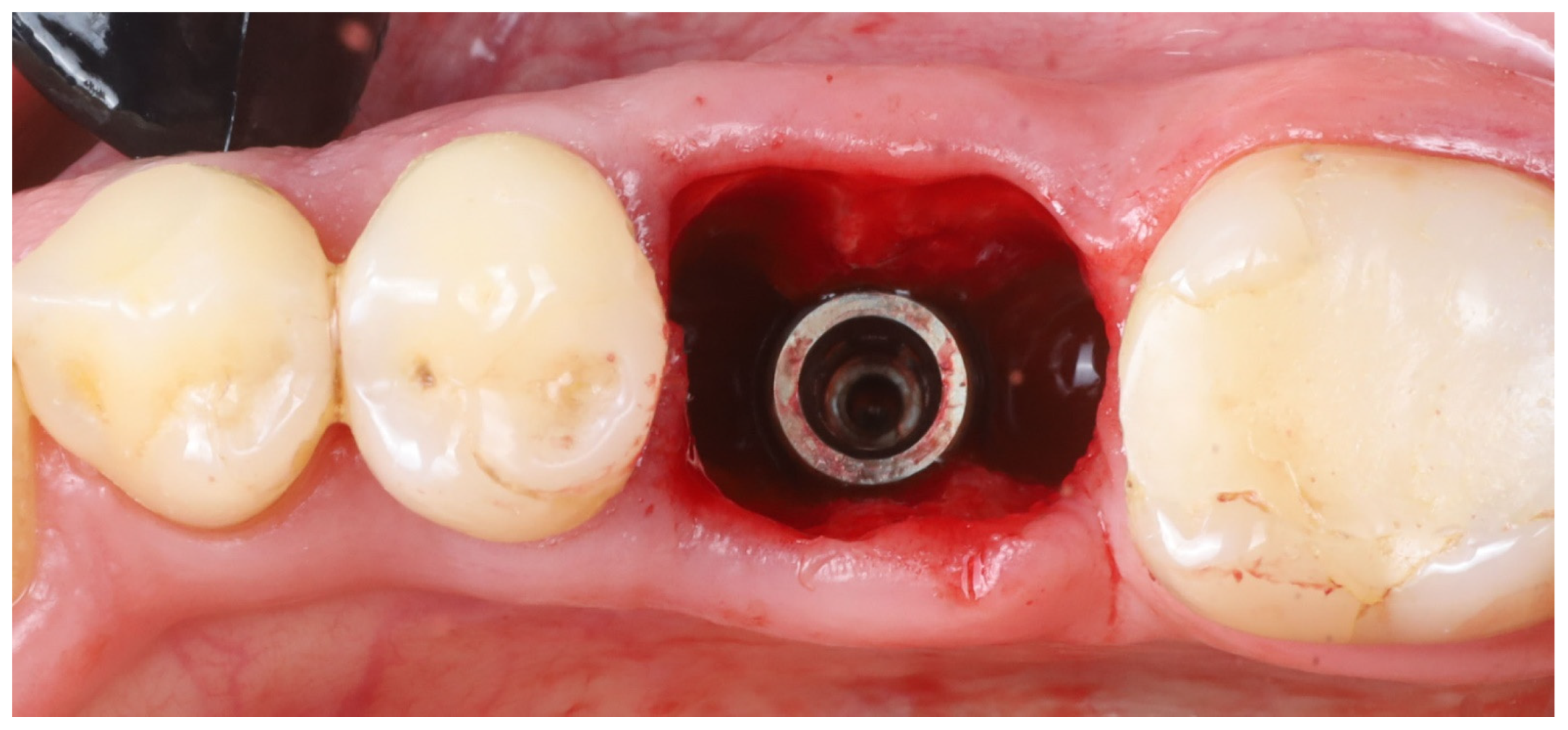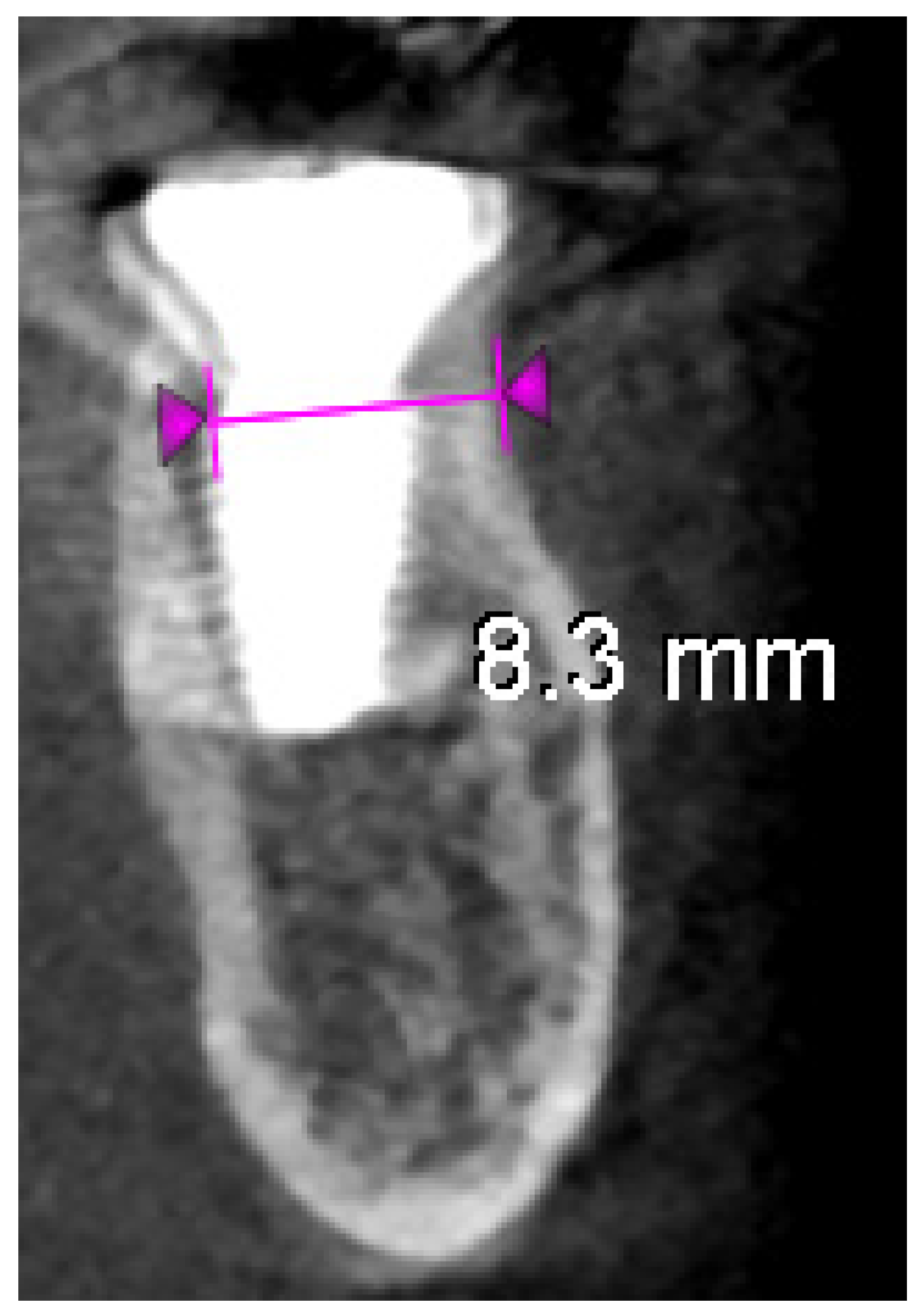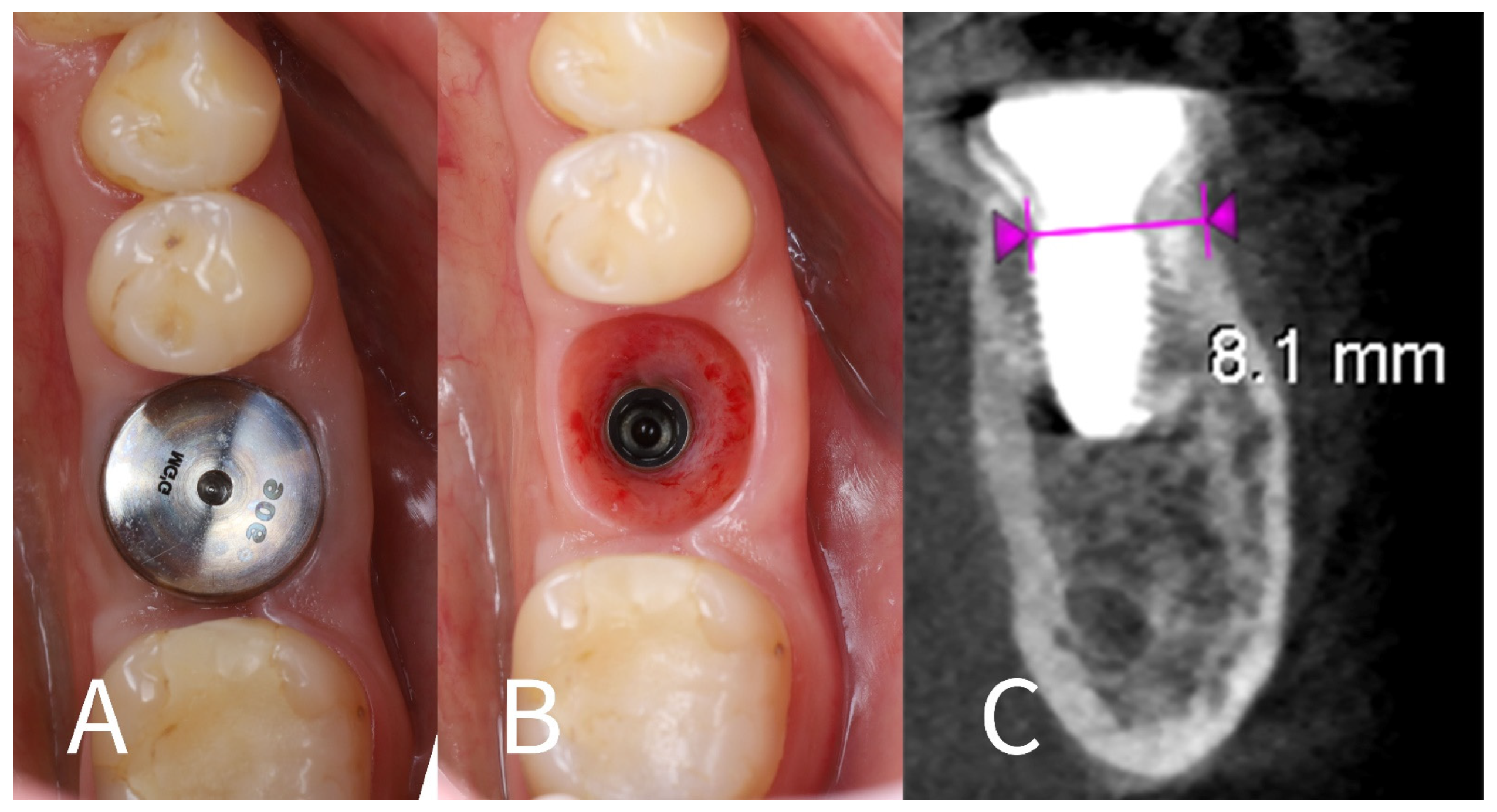Tissue Preservation Using Socket-Shield Technique in Lower Molar Site: A Proof of Principle Report
Abstract
1. Introduction
2. Materials and Methods/Technique/Results
- 1.
- Root sectioning: After performing mandibular nerve block anesthesia, the crown of tooth #36 (Figure 2A) was removed (decoronation was performed) (Figure 2B). The mesial and distal roots were then separated buccolingually using a long-shanked, straight diamond bur in a high-speed handpiece with copious irrigation (Figure 2C). The preoperative CBCT was consulted to guide the depth and orientation of the cuts, accounting for the roots’ length, curvature, and angulation.
- 2.
- Partial root extraction: Each root was sectioned in a mesiodistal direction approximately 1–1.5 mm buccally from the center of each root surface to a depth of about two-thirds of the root length, using a #2 long cylinder bur from Gluckman’s partial extraction therapy (PET) surgical kit (Megagen, Seoul, South Korea). This created buccal and lingual segments for each root. The lingual root segments (along with their apices) were carefully extracted, leaving only the buccal portions of the roots in place as the “socket shields” (Figure 2D). If the lingual part fails to extract and remains in the socket still attached to the shield, it should be detached from the shield with bur #3 and extracted in the conventional way. In such cases, the bony septum can be drilled in the center to facilitate extraction.
- 3.
- Shield preparation (thinning): The remaining buccal root segments were refined to serve as socket shields. Each shield was thinned to approximately 1 mm thickness using a large round diamond bur (#3), and the internal (lingual) surface of each shield—facing the future implant—was smoothed with a finer grit bur (#4) (Figure 3). It is important that the shields are thin; leaving them thicker than ~1 mm can increase the risk of complications such as inner (internal) shield exposure during healing.
- 4.
- Shield length adjustment: If necessary, the apical extent of each buccal shield was reduced using the same large round bur. The goal was to ensure that each shield’s total height was no more than roughly two-thirds of the original root length. This prevents the shield from extending too far apically beyond where the implant will be placed.
- 5.
- Crestal trimming of shields: The coronal height of each shield was reduced to the level of the surrounding buccal alveolar bone crest. This was achieved with finer burs (#5 and #6). Ensuring the shield does not protrude above the bone is critical, as a shield that is too high can become exposed through the gingiva (external shield exposure) [7].
- 6.
- Socket debridement: The extraction sockets were thoroughly debrided, especially in the apical areas, to remove any residual soft tissue or infection (granulation tissue). The sockets were then vigorously irrigated with sterile saline to clean out any small root/bone particles created during drilling. This step helps create a clean environment for healing.
- 7.
- Intraoperative radiographic check: A periapical radiograph can be taken intraoperatively to verify that no residual root fragments, root canal filling material, or root apices were left behind. This radiographic check can confirm that only the intended buccal root shields remained in situ.
- 8.
- Shield stability verification: Each buccal shield was tested for stability by probing gently with a sharp explorer on its internal aspect. Both shields remained completely immobile. (If a shield had exhibited mobility, the socket-shield approach for that root would be aborted, as a mobile or dislodged shield could compromise healing.)
- 9.
- Shield integrity check: Using magnification (surgical loupes), the shields were inspected for any cracks or fractures. Both shields were intact, with no visible cracks. If a shield were found to be cracked, it would also necessitate abandonment of the SST for that site because a fractured shield could lead to infection or unpredictable bone healing.
- 10.
- Implant osteotomy preparation: An implant osteotomy was created in the inter-radicular septum (furcation bone) of the extraction site [16]. Sequential drilling (using the standard Blue Diamond implant drill kit to the 4.3 mm diameter, Megagen, South Korea) was performed. Care was taken to angle the drills to stay in the middle of the socket and avoid encroaching on the buccal or lingual plates. The osteotomy was prepared to a depth such that the future implant platform would be positioned about 5–6 mm apical to the original buccal gingival margin (as estimated from the CBCT and clinical measurements). This depth was planned to place the implant platform approximately 3–4 mm below the alveolar crest and ~6 mm below the gingival margin once the implant was in place (accounting for the soft tissue height).
- 11.
- Implant placement: A dental implant (Megagen Blue Diamond, 4.8 mm diameter × 10 mm length, conical “Deep thread” design) was inserted into the prepared osteotomy. The implant was centered within the socket, with its shoulder positioned roughly 5–6 mm below the level of the surrounding gingival margin (Figure 4). The implant fits snugly between the two buccal shields without exerting undue pressure on them. Primary stability was achieved; the implant had an insertion torque of about 35 N·cm, and verification with a resonance frequency analysis device showed an Implant Stability Quotient (ISQ) exceeding 70. (This high primary stability indicated that the implant was well stabilized in the septal bone despite the immediate placement.)
- 12.
- Socket sealing with healing cap: The socket orifice was sealed with a large-diameter healing abutment instead of suturing a flap. A wide, 9 mm diameter, and 6 mm height standard healing cap was attached to the implant, which effectively covered the socket opening and conformed to the circumference of the socket (Figure 5). This approach is intended to protect the socket and support the surrounding gingival margins without requiring a flapped closure or graft. No additional bone graft or membrane was placed in the socket; a blood clot was allowed to fill the gaps between the implant and shields [17].
- 13.
- Immediate post-op imaging: A postoperative CBCT scan was obtained to evaluate the implant position and to measure the alveolar ridge dimensions after implant placement (Figure 6). CBCT confirmed that the implant was accurately centered in the socket.
- 14.
- Postoperative care: Standard post-surgical care was implemented. The patient was instructed to rinse twice daily with a 0.2% chlorhexidine mouthwash for 2 weeks to aid plaque control during healing. A short course of systemic antibiotics was prescribed (amoxicillin 500 mg, three times a day for 3 days) as prophylaxis, and an NSAID analgesic was advised as needed for pain management. The patient was given routine post-extraction and implant care instructions, with an emphasis on gentle oral hygiene around the surgical site.
- 15.
- Follow-up in early healing: The patient was seen for follow-up at 1 week and 2 weeks post-surgery. Healing was uneventful; there were no signs of acute infection or abnormal inflammation. The soft tissue around the healing abutment remained healthy, and no exposure of the shields was observed at the gingival margin.
- 16.
- Four-month assessment:
- 17.
- Prosthetic rehabilitation: At approximately 4 months after the extraction and implant placement, the site was restored with a permanent prosthesis. A screw-retained monolithic full-contour zirconia crown (KATANA Zirconia™ YML, Kuraray Noritake Dental Inc., Tokyo, Japan) was fabricated and attached to the implant (Figure 8A). The crown was designed to have an emergence profile that matched the contour shaped by the healing abutment and surrounding tissue, thereby maintaining the ridge profile.
- 18.
- One-year follow-up: The patient was re-examined again at 12 months post-implant placement (roughly 8 months after crown delivery). The patient reported excellent function with the implant and no discomfort. A final CBCT scan at 1 year showed that the alveolar ridge dimensions were unchanged from the 4-month scan (Figure 8B). The horizontal dimension of the buccal bone had an additional resorption of only ~0.1 mm between the 4-month and 12-month time points, indicating stable hard tissue conditions. The buccal plate remained intact and fully supported the implant. The peri-implant soft tissues were healthy, with no signs of recession or inflammation around the crown. The overall result at 1 year was a stable implant with well-preserved surrounding tissues, fulfilling both functional and aesthetic expectations for a posterior implant site.
3. Discussion
4. Conclusions
Author Contributions
Funding
Institutional Review Board Statement
Informed Consent Statement
Data Availability Statement
Conflicts of Interest
Abbreviations
| CBCT | Cone-beam computed tomography |
| GBR | Guided bone regeneration |
| PDL | Periodontal ligament |
| PET | Partial extraction therapy |
| SST | Socket-shield technique |
References
- Ruales-Carrera, E.; Pauletto, P.; Apaza-Bedoya, K.; Volpato, C.A.M.; Özcan, M.; Benfatti, C.A.M. Peri-implant tissue management after immediate implant placement using a customized healing abutment. J. Esthet. Restor. Dent. 2019, 31, 533–541. [Google Scholar] [CrossRef] [PubMed]
- Elgali, I.; Omar, O.; Dahlin, C.; Thomsen, P. Guided bone regeneration: Materials and biological mechanisms revisited. Eur. J. Oral Sci. 2017, 125, 315–337. [Google Scholar] [CrossRef] [PubMed]
- Laverty, D.P.; Buglass, J.; Patel, A. Flapless dental implant surgery and use of cone beam computer tomography guided surgery. Br. Dent. J. 2018, 224, 591–602. [Google Scholar] [CrossRef]
- Hürzeler, M.B.; Zuhr, O.; Schupbach, P.; Rebele, S.F.; Emmanouilidis, N.; Fickl, S. The socket-shield technique: A proof-of-principle report. J. Clin. Periodontol. 2010, 37, 855–862. [Google Scholar] [CrossRef]
- Bäumer, D.; Zuhr, O.; Rebele, S.; Schneider, D.; Schupbach, P.; Hürzeler, M. The Socket-Shield Technique: First Histological, Clinical, and Volumetrical Observations after Separation of the Buccal Tooth Segment—A Pilot Study. Clin. Implant Dent. Relat. Res. 2015, 17, 71–82. [Google Scholar] [CrossRef]
- Gluckman, H.; Du Toit, J.; Salama, M. The Pontic-Shield: Partial Extraction Therapy for Ridge Preservation and Pontic Site Development. Int. J. Periodontics Restor. Dent. 2016, 36, 417–423. [Google Scholar] [CrossRef]
- Gluckman, H.; Salama, M.; Du Toit, J. Partial Extraction Therapies (PET) Part 2: Procedures and Technical Aspects. Int. J. Periodontics Restor. Dent. 2017, 37, 377–385. [Google Scholar] [CrossRef]
- Gluckman, H.; Salama, M.; Du Toit, J. Partial Extraction Therapies (PET) Part 1: Maintaining Alveolar Ridge Contour at Pontic and Immediate Implant Sites. Int. J. Periodontics Restor. Dent. 2016, 36, 681–687. [Google Scholar] [CrossRef]
- Kotsakis, G.A.; Nguyen, T.T.; Siormpas, K.; Pikos, M.A.; Pohl, S.; Tarnow, D.; Mitsias, M.; Root Membrane Group. Clinical outcomes of retention of the buccal root section combined with immediate implant placement: A systematic review of longitudinal studies. Clin. Implant Dent. Relat. Res. 2023, 25, 23–34. [Google Scholar] [CrossRef]
- Chappuis, V.; Araújo, M.G.; Buser, D. Clinical relevance of dimensional bone and soft tissue alterations post-extraction in esthetic sites. Periodontol. 2000 2017, 73, 73–83. [Google Scholar] [CrossRef]
- Buser, D.; Chen, S.T.; Weber, H.P.; Belser, U.C. Early implant placement following single-tooth extraction in the esthetic zone: Biologic rationale and surgical procedures. Int. J. Periodontics Restor. Dent. 2008, 28, 441–451. [Google Scholar]
- Landsberg, C.; Bender, O.; Weinreb, M.; Wigler, R.; Chackartchi, T.; Matalon, S.; Weinberg, E. Postextraction Ridge Width Alterations Following Socket Seal Surgery—A Retrospective Study. Appl. Sci. 2020, 11, 324. [Google Scholar] [CrossRef]
- Irinakis, T. Rationale for socket preservation after extraction of a single-rooted tooth when planning for future implant placement. J. Can. Dent. Assoc. 2006, 72, 917–922. [Google Scholar] [PubMed]
- Schwarz, F.; Jepsen, S.; Obreja, K.; Galarraga-Vinueza, M.E.; Ramanauskaite, A. Surgical therapy of peri-implantitis. Periodontol. 2000 2022, 88, 145–181. [Google Scholar] [CrossRef]
- Schwimer, C.W.; Gluckman, H.; Salama, M.; Nagy, K.; Du Toit, J. The socket-shield technique at molar sites: A proof-of-principle technique report. J. Prosthet. Dent. 2019, 121, 229–233. [Google Scholar] [CrossRef]
- Sayed, A.J.; Shaikh, S.S.; Shaikh, S.Y.; Hussain, M.A. Inter radicular bone dimensions in primary stability of immediate molar implants—A cone beam computed tomography retrospective analysis. Saudi Dent. J. 2021, 33, 1091–1097. [Google Scholar] [CrossRef]
- Grassi, A.; Monica, D.; Minetti, E.; Ballini, A.; Gianfreda, F.; Bollero, P.; Cicciù, M.; Mastrangelo, F. Innovative Alveolar Ridge Preservation Surgical Technique with Immediate Dental Implant Placement: A Retrospective Case Report of 1-Year Follow-Up. Eur. J. Dent. 2024, 18, 408–414. [Google Scholar] [CrossRef]
- Zaki, J.; Yusuf, N.; El-Khadem, A.; Scholten, R.J.P.M.; Jenniskens, K. Efficacy of bone-substitute materials use in immediate dental implant placement: A systematic review and meta-analysis. Clin. Implant Dent. Relat. Res. 2021, 23, 506–519. [Google Scholar] [CrossRef]
- Araújo, M.G.; Silva, C.O.; Misawa, M.; Sukekava, F. Alveolar socket healing: What can we learn? Periodontol. 2000 2015, 68, 122–134. [Google Scholar] [CrossRef]
- Chopra, A.; Sivaraman, K.; Narayan, A.I.; Balakrishnan, D. Etiology and classification of food impaction around implants and implant-retained prosthesis. Clin. Implant Dent. Relat. Res. 2019, 21, 391–397. [Google Scholar] [CrossRef]
- Gharpure, A.S.; Latimer, J.M.; Aljofi, F.E.; Kahng, J.H.; Daubert, D.M. Role of thin gingival phenotype and inadequate keratinized mucosa width as risk indicators for peri-implantitis and peri-implant mucositis. J. Periodontol. 2021, 92, 1687–1696. [Google Scholar] [CrossRef] [PubMed]
- Ramanauskaite, A.; Becker, K.; Cafferata, E.A.; Schwarz, F. Clinical efficacy of guided bone regeneration in peri-implantitis defects. A network meta-analysis. Periodontol. 2000 2023, 93, 236–253. [Google Scholar] [CrossRef] [PubMed]
- Abd-Elrahman, A.; Shaheen, M.; Askar, N.; Atef, M. Socket shield technique vs conventional immediate implant placement with immediate temporization. Randomized clinical trial. Clin. Implant Dent. Relat. Res. 2020, 22, 602–611. [Google Scholar] [CrossRef] [PubMed]








Disclaimer/Publisher’s Note: The statements, opinions and data contained in all publications are solely those of the individual author(s) and contributor(s) and not of MDPI and/or the editor(s). MDPI and/or the editor(s) disclaim responsibility for any injury to people or property resulting from any ideas, methods, instructions or products referred to in the content. |
© 2025 by the authors. Licensee MDPI, Basel, Switzerland. This article is an open access article distributed under the terms and conditions of the Creative Commons Attribution (CC BY) license (https://creativecommons.org/licenses/by/4.0/).
Share and Cite
Simuntis, R.; Tušas, P.; Ražanauskienė, A.; Rutkūnas, V.; Leketas, M. Tissue Preservation Using Socket-Shield Technique in Lower Molar Site: A Proof of Principle Report. Dent. J. 2025, 13, 145. https://doi.org/10.3390/dj13040145
Simuntis R, Tušas P, Ražanauskienė A, Rutkūnas V, Leketas M. Tissue Preservation Using Socket-Shield Technique in Lower Molar Site: A Proof of Principle Report. Dentistry Journal. 2025; 13(4):145. https://doi.org/10.3390/dj13040145
Chicago/Turabian StyleSimuntis, Regimantas, Paulius Tušas, Aušra Ražanauskienė, Vygandas Rutkūnas, and Marijus Leketas. 2025. "Tissue Preservation Using Socket-Shield Technique in Lower Molar Site: A Proof of Principle Report" Dentistry Journal 13, no. 4: 145. https://doi.org/10.3390/dj13040145
APA StyleSimuntis, R., Tušas, P., Ražanauskienė, A., Rutkūnas, V., & Leketas, M. (2025). Tissue Preservation Using Socket-Shield Technique in Lower Molar Site: A Proof of Principle Report. Dentistry Journal, 13(4), 145. https://doi.org/10.3390/dj13040145






